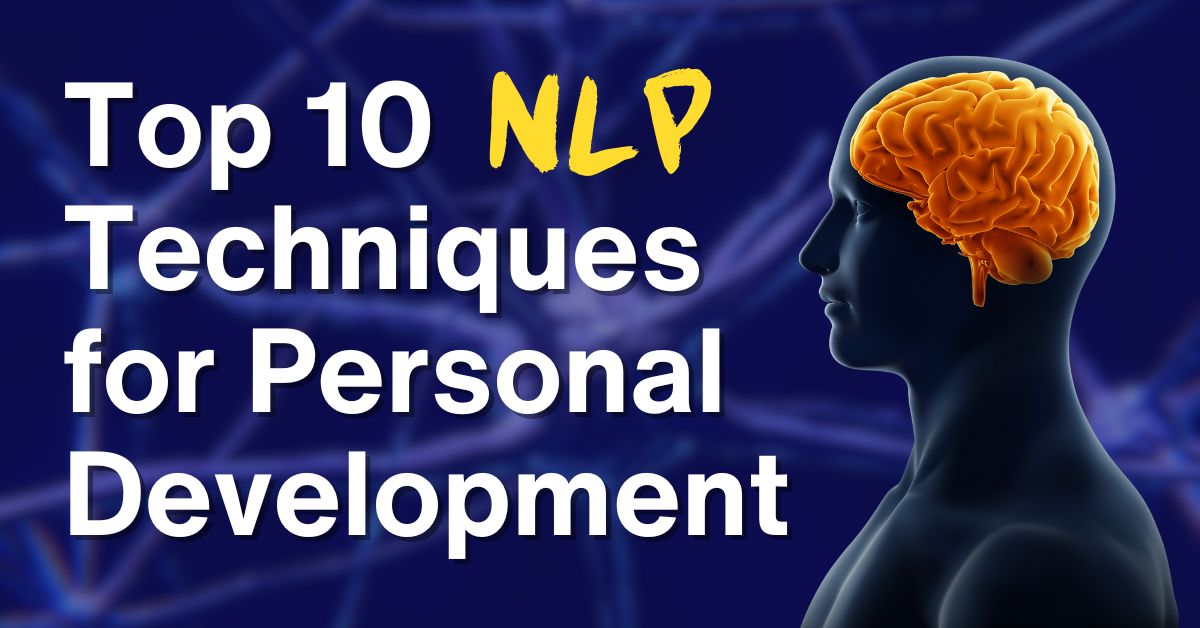Imagine waking up every day with a clear sense of purpose, feeling confident and equipped to tackle life’s challenges. Yet, for many of us, there are moments when self-doubt, unproductive habits, or negative thinking hold us back from reaching our full potential. Neuro-Linguistic Programming (NLP) offers a proven way to break through these mental barriers and create lasting change.
By mastering NLP techniques, you can shift your mindset, boost self-esteem, improve relationships, and achieve your goals with newfound clarity. Whether you’re looking to overcome personal hurdles or simply elevate your everyday life, these tools can make all the difference.
In this article, we’ll dive into the top 10 NLP Techniques for Personal Development that can help you unlock your potential, transform your habits, and set you on the path to personal success. Ready to change the way you think and live?
Let’s explore the powerful impact of NLP.
1. Anchoring: Create Emotional Triggers for Positive States
Using the NLP approach of anchoring, you can associate a certain mental or physical activity with a desired emotional state. Just by doing something as easy as tapping your wrist or repeating a word, you could quickly access sensations of motivation, self-assurance, or serenity.

This method makes it possible for you to instantly access happy feelings, which can be tremendously helpful in high-stress scenarios like public speaking, interviews, or demanding meetings.
Real-world example: One of my clients had trouble speaking in front of groups of people and frequently felt extremely anxious. Using the anchoring technique, we collaborated. She would softly touch her wrist to reinforce her confidence each time it occurred during practice sessions.
Gradually, the act of caressing her wrist evolved into her emotional “trigger.” She would activate this anchor prior to every presentation, instantly bringing back those confident sensations.
She was able to enter the stage confidently and composed as a result, completely changing her speaking experience.
Regaining control over your emotional state through anchoring is a useful and effective strategy that will enable you to tackle obstacles with ease and confidence.
2. Reframing: Change Your Perspective, Change Your Outcome
In the fast-paced world of business, challenges are inevitable. However, how you choose to see those challenges can make all the difference. This is where the NLP technique of reframing comes in.

Reframing is all about shifting your perspective. Instead of seeing a setback as a failure, you learn to view it as an opportunity for growth or a learning experience. It’s not about denying reality but about finding a more empowering way to interpret situations.
Imagine you’ve just lost a major client. Instead of focusing on the loss, reframing allows you to ask, “What can I learn from this? How can I improve my approach moving forward?” By changing your mindset, you’re better equipped to find solutions, take proactive steps, and turn the situation around.
For professionals and entrepreneurs, reframing can be a game-changer. When faced with challenges whether it’s a tough negotiation, a missed opportunity, or a team setback this technique helps you stay focused on possibilities rather than problems. It empowers you to adapt quickly, find hidden opportunities, and maintain a positive, productive mindset, no matter the situation.
Ultimately, reframing isn’t just a mental shift; it’s a tool that can transform outcomes in your business and personal life, helping you lead with resilience and clarity.
3. Visualization: Picture Success for Motivation
In business, the ability to see a clear path forward is essential. With the NLP technique of visualization, you can take this a step further by mentally picturing your success before it happens. Visualization taps into the power of your mind to boost motivation, enhance focus, and drive you toward achieving your goals.

Think of it as creating a mental rehearsal. By vividly imagining yourself succeeding whether it’s closing a big deal, delivering a powerful presentation, or achieving a key milestone you train your brain to recognize these outcomes as achievable. This mental practice helps reduce anxiety, increase confidence, and prepare you to perform at your best.
For example, before an important meeting, take a moment to close your eyes and visualize the entire process, from greeting your client to confidently presenting your ideas and receiving positive feedback. Imagine the details—the tone of your voice, your body language, and the reactions from your audience. This technique primes your mind for success, making you feel more in control and motivated.
Professionals and entrepreneurs can use visualization to stay focused on long-term goals and maintain the drive to push through challenges. By picturing the desired outcome, you’re not just daydreaming you’re creating a clear mental roadmap to success.
When you practice visualization regularly, it becomes a powerful tool for fueling motivation and helping you achieve your goals with clarity and confidence.
4. Swish Pattern: Break Negative Habits Quickly

Breaking negative habits can feel like an uphill battle, especially when those habits seem deeply ingrained. That’s where the NLP technique known as the Swish Pattern comes in a powerful technique designed to help you quickly shift away from unproductive behaviors and replace them with positive, empowering actions.
The Swish Pattern works by reprogramming your mind to create new associations. Instead of automatically falling into old, negative patterns, you learn to redirect your thoughts and actions toward a desired outcome. This technique taps into the subconscious mind, helping you break free from habits that hold you back.
Imagine you have a habit of procrastinating when faced with a big task. With the Swish Pattern, you would first identify the mental image or feeling that triggers your procrastination. Then, you replace it with a vivid picture of yourself taking immediate action focused, motivated, and accomplishing the task with ease. Over time, your brain starts associating the old trigger with this new, positive image, making it easier to adopt productive habits.
For business professionals, the Swish Pattern can be a game-changer. Whether it’s overcoming procrastination, managing stress, or stopping unproductive thought patterns, this technique empowers you to take control of your behaviors quickly and effectively.
By using the Swish Pattern regularly, you can break negative habits at their source, helping you create more positive routines that drive both personal and professional success.
5. Mirroring: Build Instant Rapport
In business, relationships are everything. Whether you’re negotiating a deal, leading a team, or meeting with clients, building rapport quickly can make all the difference. One effective NLP technique for this is mirroring the subtle art of mimicking someone’s body language, tone, or speech patterns to create a sense of connection.
Mirroring works because people naturally feel more comfortable with those who seem familiar or similar to them. Subtly reflecting someone’s gestures, posture, or pace of speech signals that you’re on the same wavelength, fostering trust and rapport.
Imagine sitting across from a potential client during a meeting. By noticing their body language perhaps they lean forward while speaking or use hand gestures you can gently mirror these behaviors. This technique isn’t about copying exactly, but about subtly aligning yourself with the other person’s energy and style. The result? They feel more at ease and connected to you.
For business professionals, mastering mirroring can be a game-changer in negotiations, sales, or team interactions. It allows you to build rapport quickly, making conversations smoother and more effective. When people feel understood and comfortable, they’re more likely to trust and collaborate with you.
Mirroring is a simple yet powerful technique for creating strong, positive connections essential for building lasting business relationships and achieving successful outcomes.
6. Parts Integration: Resolve Internal Conflicts
As professionals, we often find ourselves torn between different goals or desires, leading to internal conflicts affecting our decision-making and productivity. Parts Integration, an NLP technique, helps resolve these internal struggles by aligning conflicting parts of ourselves.

We all have different “parts” of our personality that influence our actions. For example, one part of you might be focused on achieving success, while another part craves balance and relaxation. These opposing forces can create tension, making it difficult to move forward confidently. Parts Integration helps you reconcile these conflicting desires by finding common ground and aligning your inner motivations.
Imagine you’re torn between working overtime to meet a deadline and wanting to spend more time with your family. Using Parts Integration, you’d first acknowledge both parts the one driven by ambition and the one seeking family time. Through the process, you explore the positive intentions behind each part and work toward a resolution where both needs are respected. Perhaps you find a way to be more efficient with your time, ensuring success at work while preserving personal time.
For business leaders and entrepreneurs, resolving internal conflicts can unlock greater clarity, reduce stress, and lead to more balanced decision-making. By using Parts Integration, you create a sense of inner harmony, allowing you to move forward with confidence and alignment in both your personal and professional life.
This technique is invaluable for anyone looking to eliminate inner resistance and operate at their full potential.
7. Meta Model: Uncover Hidden Beliefs and Clarify Thoughts
In business, communication is key, yet misunderstandings often arise from unclear language or unspoken assumptions. The Meta Model, a powerful NLP technique, helps uncover hidden beliefs and clarify thoughts by challenging vague or limiting language patterns. It’s a tool designed to dig deeper into what someone is truly saying, helping you get to the root of their thoughts and beliefs.
The Meta Model works by asking specific, probing questions to clarify statements. When people speak in generalizations or make assumptions, this technique helps break down those ideas and bring more precision to the conversation. As a result, you gain a clearer understanding of their mindset, which allows you to address concerns or provide more targeted solutions.
Imagine a team member says, “I’m just not good at presentations.” Rather than accepting that statement at face value, the Meta Model would prompt you to ask, “What specifically makes you feel that way?” or “Can you think of a time when you did well in a presentation?” By challenging the generalization, you help the person move beyond their limiting belief and open up new possibilities for growth.
For business leaders and professionals, mastering the Meta Model can lead to more effective communication, better problem-solving, and a deeper understanding of both your own thoughts and those of others. It helps remove ambiguity, enabling you to tackle issues with greater clarity and confidence.
By using the Meta Model, you can uncover hidden assumptions, challenge limiting beliefs, and create conversations that drive meaningful action and growth.
8. Milton Model: Influence Through Language
In the world of business, the ability to influence and inspire through language is a valuable skill. The Milton Model, an NLP technique, equips you with subtle language patterns that encourage others to think, feel, or act in a particular way without resistance. It’s named after Milton Erickson, a renowned hypnotherapist who mastered the art of using vague and suggestive language to influence positive outcomes.
The Milton Model works by creating open-ended suggestions that allow the listener to fill in the details themselves, leading them toward your desired outcome. This technique is particularly useful in negotiations, leadership, and sales, where the goal is to guide someone’s thinking without being overly direct or confrontational.
Imagine you’re leading a team and want them to embrace a new project. Instead of saying, “We need to do this,” which can sound forceful, you might use the Milton Model by saying, “You may begin to realize how this project could open up exciting new opportunities.” This language invites your team to come to their own conclusion, making them feel more empowered and engaged in the decision.
For business professionals, the Milton Model helps build rapport, reduce resistance, and encourage collaboration. It’s an elegant way to influence without pressure, allowing others to feel they are making their own choices while gently guiding them toward your goals.
By mastering the Milton Model, you can use language as a powerful tool to inspire action, foster agreement, and create positive outcomes in both personal and professional interactions.
9. Future Pacing: Mentally Rehearse Success
Using an NLP method called Future Pacing, you mentally practice future events to train your brain toward success. Seeing oneself effectively navigate forthcoming circumstances helps you not only lower anxiety but also train your body and mind to react confidently and positively. It’s like building a mental road map that guides you toward increased readiness and control upon the time of arrival.
In reality: Future pace allows a worried keynote speaker to mentally practice their speech. They see themselves boldly on stage, making the speech flawless and getting great comments from the crowd.
Through repeated mental practice of this scenario, the speaker lowers anxiety and increases confidence, so enabling the real situation to seem familiar and under control.
Future pacing is a great approach to increasing confidence and lowering anxiety. It will help you enter demanding events calmly and ready.
10. Timeline Therapy: Let Go of Past Traumas
In both business and personal life, unresolved emotions from the past can hold us back, creating mental barriers that affect our performance and decision-making. Timeline Therapy, an NLP technique, helps individuals let go of past traumas, limiting beliefs, and negative emotions by reprogramming how they perceive those experiences. It’s a powerful tool for freeing yourself from the emotional weight hindering your growth.

Timeline Therapy allows you to mentally revisit past events, but instead of reliving the pain, you view them from a neutral perspective—detaching the emotional charge associated with those memories. By doing this, you can release the negative feelings and create space for new, empowering beliefs that align with your present and future goals.
For instance, imagine you’re struggling with a fear of failure because of a past business setback. Through Timeline Therapy, you’d revisit that event, not to relive the disappointment but to reinterpret it as a learning experience. This shift in perspective allows you to release the fear and move forward with confidence and clarity.
Letting go of past emotional blocks can unlock tremendous potential for entrepreneurs, professionals, and leaders. Whether it’s anxiety about past failures, lingering self-doubt, or deep-rooted stress, Timeline Therapy enables you to overcome these obstacles and move forward with a fresh, positive mindset.
This technique helps you break free from the emotional baggage of the past, allowing you to make decisions and take action with greater confidence, clarity, and emotional freedom.
FAQs
What is NLP, and how can it help you grow as a person?
Neuro-linguistic programming, or NLP, is a powerful method that can help people change their bad habits, ways of thinking, and actions. By using certain NLP methods, people can change their thoughts, feel more confident, and improve their emotional health, which can lead to personal growth and success.
What does anchoring mean in NLP and how does it help manage emotions?
Anchoring is a type of NLP that helps you connect a thought or physical action with a good feeling. This method helps you quickly feel confident, motivated, or calm when needed, especially when you’re under a lot of stress.
What are the pros of reframing with NLP?
By changing how you think about problems, reframing can help you turn losses into growth chances. By changing how you think about tough situations, reframing turns what you think are mistakes into useful lessons that can help your personal and professional growth.
How can the Swish Pattern help you break bad habits?
An NLP method called the Swish Pattern can help you change bad habits into good ones. This method changes how your brain works so that you can break old habits and start doing new, helpful things, like not putting things off.
How does Future Pacing in NLP help lower stress and boost confidence?
Future Pacing lets you practice what might happen in the future, getting your mind and body ready for success. Visualizing good things happening helps you feel less anxious and more confident, which makes you better prepared to handle things easily in real life.
Conclusion
Neuro-linguistic programming (NLP) offers a wide range of practical techniques designed to help you overcome mental barriers, unlock potential, and create lasting positive change in your personal and professional life. Whether you’re breaking negative habits with the Swish Pattern, building instant rapport with Mirroring, or releasing emotional baggage through Timeline Therapy, these techniques are powerful, effective, and accessible.
For professionals, entrepreneurs, and leaders, mastering NLP techniques like the Milton Model, Parts Integration, and Reframing can make all the difference in how you communicate, influence, and navigate challenges. These strategies empower you to operate at your best whether you’re leading teams, negotiating deals, or seeking personal growth.
By integrating NLP into your daily routine, you can cultivate a mindset of success, strengthen your relationships, and overcome any obstacles standing in your way. The techniques shared here are not just theoretical they offer real, actionable steps to help you achieve your goals and thrive in every aspect of your life.





